Every individual award winner in Buffalo Sabres history

If you are a new fan of the Buffalo Sabres, definitely take some time to check out this article as we outline every individual award winner in team history.
It’s safe to say the Buffalo Sabres have seen some prominent names on some prominent pieces of hardware. And when you look at today’s long list, you will know just how relevant they were once upon a time.
Below and in the following slides, we have 23 names and, thanks to Dominik Hasek among other players, over 30 different individual award winners. So are you ready to journey back in time and relive some of the most legendary seasons in team history that capped off with someone winning an individual award? Keep reading.
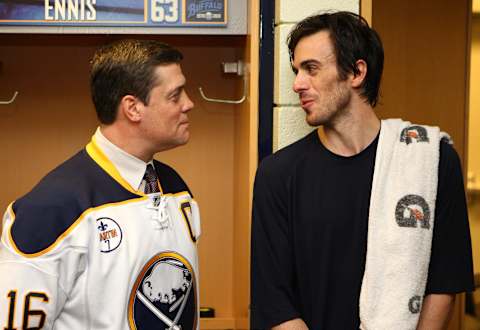
A glance at every award winner in Buffalo Sabres history – Bill Masterton Memorial Trophy
Two players on the Buffalo Sabres were worthy enough to win the Masterton Memorial Trophy. This award goes to the player who displays an immense passion for the game, especially in terms of sportsmanship and persistence.
Don Luce (1974-75)
While monster numbers are not required to win the Masterton, Don Luce saw 76 points in 80 games when he won the award. 33 of those points went for goals, and his 13.5 shooting percentage was the highest of his career at the time before he eventually set a permanent high at 17.4 percent in 1978-79. However, his points total in 1974-75 remained a career best.
Pat LaFontaine (1994-95)
LaFontaine proved what winning the Masterton really means when he snagged the award in 1994-95, having played in just 22 games. But they were an incredible 22 games, played between March 16th and May 1st, 1995. He scored 27 points, 12 goals, and 15 assists. The following season, LaFontaine returned to form with 91 points, 40 goals, and 51 assists in 76 contests.
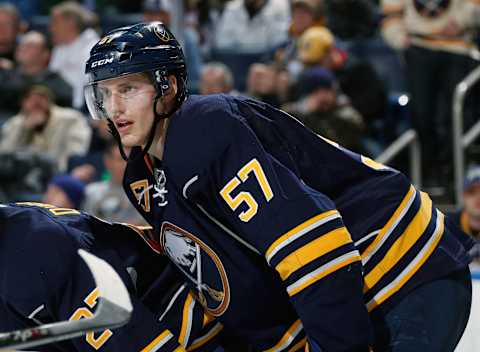
Calder Memorial Trophy
Think of the Calder Memorial Trophy as the NHL’s version of Rookie of the Year. And over the Buffalo Sabres half-century of existence, they have been lucky enough to see three Calder recipients.
Gilbert Perreault (1970-71)
Perreault finished 13th for the Hart Trophy and fifth for the Byng that season, foreshadowing what was to come in later years. But in 1970-71, the rookie scored 72 times in 79 contests, recording 38 goals and 34 assists.
Tom Barrasso (1983-84)
Barrasso may have had one of the best rookie seasons in NHL history. Not only did he win the Calder; he also took home First Team All-Rookie honors, earned a spot as a First Team All-Star, and he won the Vezina. Barrasso allowed just 117 goals, with an 0.893 save percentage and 2.85 GAA. He finished the season with a record of 26-12-3.
Tyler Myers (2009-10)
Myers has not enjoyed the most successful NHL career. But during his rookie season in 2009-10, he was also a First Team All-Rookie and he also drew consideration for the Norris. Myers’ 133 blocks were a career high until 2021-22, when he recorded 148. What remains a career high from 2009-10 are his point totals, in which he scored 11 goals, 37 assists, and 48 points.
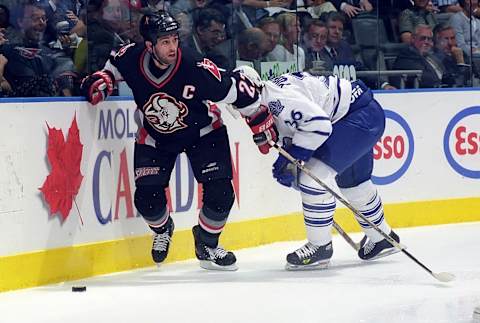
Frank J. Selke Trophy
The Frank J. Selke Trophy goes to the forward who showed the best defensive prowess among their peers. The Buffalo Sabres have been fortunate enough to see two Selke winners since the 1984-85 season.
Craig Ramsay (1984-85)
Often, as a player ages, their skills decline. But Ramsay was the one exception to that rule. He didn’t win the Selke until his final season at age 34. Between 1978 and 1982, he finished no worse than third for the coveted award. And he finished in the top five in 1984, after taking seventh in 1983 before finally snagging it in 1985. He scored just 33 points that season, but clearly, Ramsay’s success on defense deemed him worthy of the honor.
Michael Peca (1996-97)
Younger fans may know Peca as the assistant coach of the Rochester Americans. But before that, he was one of the better defensive forwards for the Sabres. So much, that he twice won the Selke, with the first occurrence coming in 1996-97, before the second occurred in 2002 (with the New York Islanders). Want more fun? Peca finished no worse than fifth for the prize between 1997 and 2004.
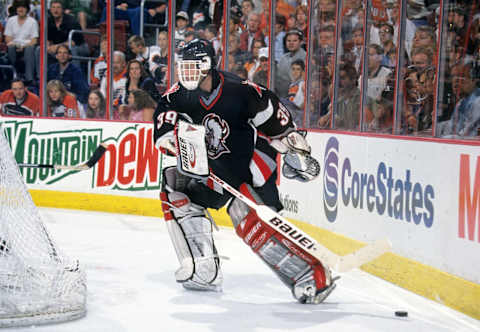
Hart Memorial Trophy
Think of the Hart as the League MVP in pro sports, or equivalent to the Heisman Trophy in college football. It is an award that only one member of the Buffalo Sabres has won thus far.
Dominik Hasek (1996-97, 1997-98)
They called Dominik Hasek the Dominator for a reason. He is, to this day, the only goaltender in NHL history to win the Hart Memorial Trophy twice. You will see his name pop up in other slides in this article, and it is a testament of how good he really was. But let’s focus on Hasek’s two MVP seasons.
The first of which occurred in 1996-97. In that year, he posted a 0.930 save percentage, plus a 2.27 GAA. He notched a career high 37 wins with the Sabres, which he would break in 2001-02 as a member of the Detroit Red Wings.
In 1997-98, he won the Hart for the second year running, one of very few players in NHL history to win the award. He logged a GAA of just 2.09 and a save percentage of 0.932. He lost 23 games that year, but if it wasn’t for Hasek, the Sabres may not have been competitive.
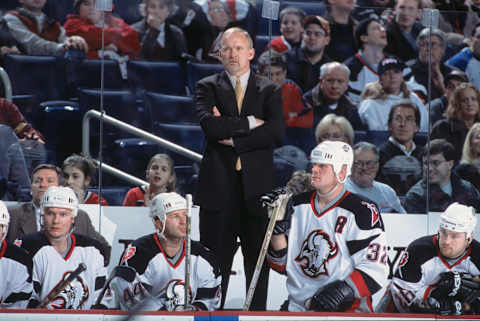
Jack Adams Award
The Jack Adams Award goes to the coach who exceeded everyone’s wildest expectations for the season. They don’t necessarily need to win the Presidents’ Trophy or the Stanley Cup – these coaches just need to take their team further than anyone would have thought.
Ted Nolan (1996-97)
It was a year the Buffalo Sabres finished first in the NHL’s Northwest Division, with a 40-30-12 record, good for 92 points. Pat LaFontaine served as the captain while the team as a whole finished just sixth in goals allowed, so it’s no wonder Dominik Hasek won the Hart Trophy that year.
The Sabres were so impressive, that they faced +4,000 odds to win the Stanley Cup. They were supposed to be so bad, that only six teams had longer odds. Instead, they went to the playoffs and beat the Ottawa Senators in a thrilling, seven-game series, before losing to the Philadelphia Flyers.
Lindy Ruff (2005-06)
Before the 2005-06 season, the Sabres, like the 1996-97 team, faced long odds to win the Cup. Unlike the 1996-97 squad, their +6,000 odds were second only to the Washington Capitals, who sat at +12,000.
Instead of tanking, the 2005-06 Sabres proved everyone wrong. Having such a young team, they were table to take advantage of the 2004-05 NHL Lockout, allowing the likes of Ryan Miller, Jason Pominville, and other key players to spend an additional season in Rochester. The end result was a 110-point season and a trip to the Conference Finals, where they lost to the Carolina Hurricanes in seven games.
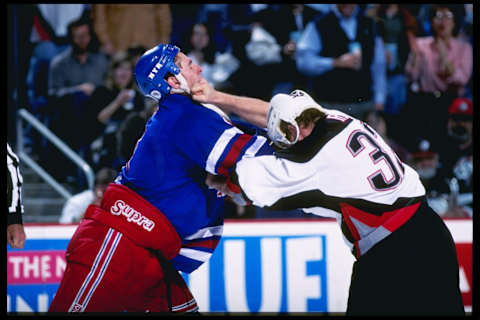
King Clancy Memorial Trophy
For those who lead not just on the ice, but also off the ice, are worthy of winning the King Clancy Memorial Trophy. Players must also take part in humanitarian efforts within the community to contend for this award.
Rob Ray (1998-99)
Ray was a staple for the Buffalo Sabres and the city of Buffalo for 14 seasons. An obvious nice guy off the ice, Ray was one of the meanest, nastiest players on the ice during his time. A true enforcer, Ray logged nearly 3,200 penalty minutes with the franchise.
He twice led the league in penalty minutes, with 350 in 1990-91 and 261 in 1998-99. His career high, however, occurred in 1991-92, when he logged 354. Career-wise, his 3,207 penalty minutes rank sixth all-time, and in nine of his 16 seasons, he took top 10 in the category.
Ray’s fighting style also warranted the NHL to adopt the Rob Ray Rule, which gave players a game misconduct if they lost their jersey during a fight. This rule stemmed from Ray’s tendency to get rid of his jersey and shoulder pads during his many fights.
Article Source: Ray: ‘It’s not something I planned’ by Jim Kelley
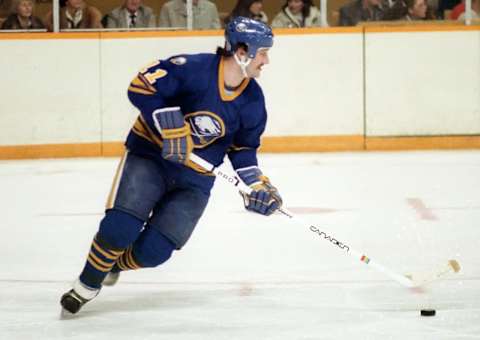
Lady Byng Memorial Trophy
This award has several criteria. The player who wins it must play at a high level. But in doing so, they must showcase an act of sportsmanship, more commonly known in league spheres as gentlemanly conduct.
Gilbert Perreault (1972-73)
Perreault won a few awards during his storied NHL career, and he snagged the Lady Byng Memorial Trophy in 1972-73. And did he display a high level of ability that season, playing in 78 games, and scoring 88 points, 28 goals, and 60 assists, plus a 12.0 shooting percentage.
Perreault was so good that season, he also took fifth place for the Hart Trophy, the third straight season in which he finished in the top five for the coveted award. But still, Perreault walked away with the Byng, and it was the last piece of hardware he won during his long career. However, he would still receive league recognition in the years that followed.
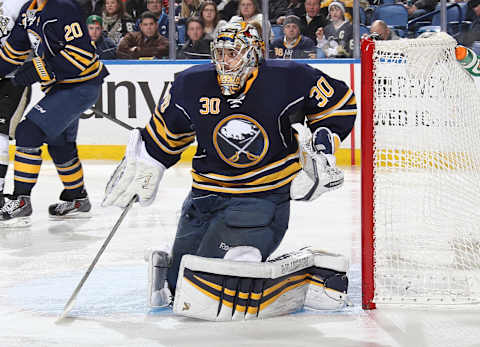
NHL Foundation Player Award
For players who exert the most community service, they will find themselves in contention for and perhaps winning the NHL Foundation Player Award. The Buffalo Sabres were lucky enough to have two players take it.
Rob Ray (1998-99)
In the same season he won the King Clancy Memorial Trophy, Rob Ray took home the NHL Foundation Player Award. As mentioned in one of the previous slides, it was ironic to see one of the NHL’s most aggressive enforcers take home the good guy awards, but Ray served as a prime example of a player who left everything on the ice.
Ryan Miller (2009-10)
Ryan Miller was everything the Sabres could have asked for in the post-Hasek era. Besides winning the NHL Foundation Player Award that season, Miller also looked good as the netminder. He was a First Team member of the NHL All-Star Team, finished fourth for the Hart, and he won the Vezina.
Miller finished the season with a 41-18-8 record, a 0.929 save percentage, and an amazing 2.22 GAA. Had he won the Hart that year, he would have joined Dominik Hasek as two Sabres goaltenders to have taken the coveted prize.
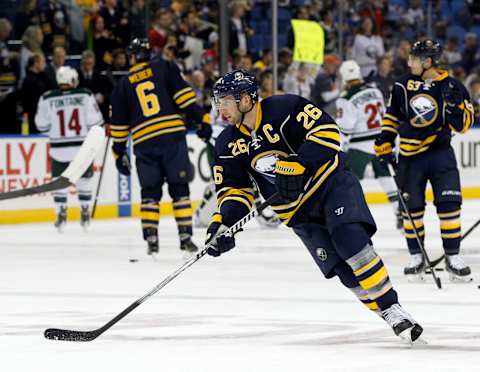
NHL Plus-Minus Award
The plus-minus statistics may be controversial to some fans. But it can indicate how effective the team is with the player on the ice. And in 2006-07, Thomas Vanek was that player.
Thomas Vanek (2006-07)
Vanek won more than just the Plus-Minus award that year; he was also a First Team NHL All-Star and he was in contention for the Selke, Hart, and Byng Trophies. Vanek finished the season with a plus-minus of 47, which also went with 84 points, 43 goals, and 41 assists in 82 contests. He also logged an 18.1 shooting percentage, which became one of the best of his career.
While Vanek didn’t receive another major award following the 2006-07 season, he ended up playing in the 2009 All-Star Game. Overall, Vanek was a valuable asset to the Buffalo Sabres mid-2000s teams, which made two deep playoff runs. He would also finish in the top 10 in NHL All-Star voting on two more occasions.
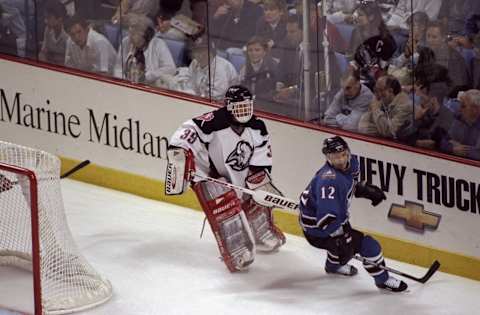
Ted Lindsay Award
This is another MVP award, except the NHL Players’ Association chooses who wins this one. Dominik Hasek won several awards multiple times during his illustrious career, and the Lindsay Award – then known as the Pearson Award – is one of them.
Dominik Hasek (1996-97, 1997-98)
Many call Hasek one of the best, if not the best goaltender in NHL history. And his time with the Buffalo Sabres and even after he left the Queen City backs up that claim. During his legendary 1996-97 season, Hasek also won the Vezina and Hart Trophies.
And while the Sabres were not a great team that year, his performances helped them win a division championship and snag the second seed in the playoffs. In 1997-98, the Sabres took a small step back, finishing with 89 points. But Hasek’s performances again won him the Vezina, Hart, and Lindsay Awards. And he eventually led them to the Eastern Conference Finals.
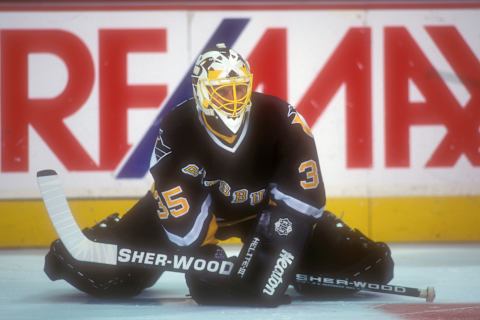
Vezina Trophy
The Vezina Trophy goes to the league’s best goaltender, but once upon a time, it also went to the goaltender(s) who finished with the fewest number of goals allowed. Starting in 1981, the Jennings Trophy took on that role.
Don Edwards and Bob Sauve (1979-80)
The only Buffalo Sabres goaltending duo to win the award under its original definition, Edwards and Sauve allowed a grand total of 199 goals, with Edwards posting an astounding 2.36 GAA. One member of the duo would win the Jennings Trophy for the same criteria in 1984-85.
Tom Barrasso (1983-84)
Earlier, I mentioned Barrasso may have had the greatest rookie season of any goaltender in NHL history. How many goaltenders snag the Vezina and the Calder in the same season? And while Barrasso never won the Vezina again, he would contend for it on several occasions, finishing in the top 10 for the award seven times.
Dominik Hasek (1993-94, 1994-95, 1996-97, 1997-98, 1998-99, 2000-01)
It will always be up for debate over who the best goaltender in NHL history is. But Hasek made his case with six Vezinas. And as you have seen throughout this article, they are just a few of his many awards and honors.
Ryan Miller (2009-10)
On many other NHL teams, Miller would be considered the best goaltender in franchise history. He finishes second only to Hasek in Buffalo Sabres history as one of only five goaltenders to win the award.
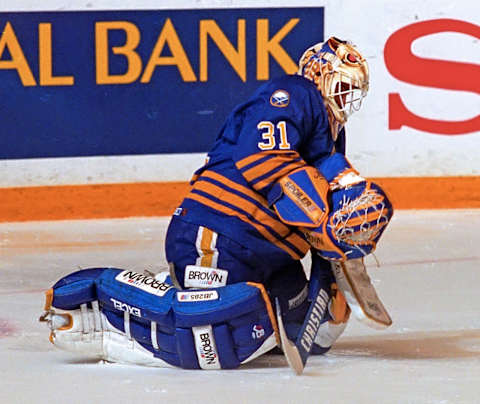
William M. Jennings Award
Since 1981, the Jennings Award took over for the Vezina in terms of which goaltender(s) allowed the least amount of goals. The Buffalo Sabres saw three goaltenders take the honor.
Tom Barrasso, Bob Sauve (1984-85)
Sauve won the award once with Edwards, then he flipped around and won it with Barrasso. That season, he allowed 84 goals while Barrasso allowed just 144. Barrasso also recorded a 2.67 GAA.
Grant Fuhr, Dominik Hasek (1993-94)
Hasek dominated the NHL landscape in the 1990s, but in 1993-94, he had a tag team partner for the Jennings Award in Grant Fuhr. Fuhr, a journeyman at this point in his Hall of Fame career, allowed just 106 goals while Hasek’s 109 was en route to a 1.95 GAA and a 0.930 save percentage.
Who are the five most forgotten Sabres?. light. More
Dominik Hasek (2000-01)
And finally, Hasek won the award in 2000-01. It was the 36-year-old’s final season with the Buffalo Sabres, but undoubtedly a memorable one. Once again, he won the Vezina and finished in eighth for the Hart. But his 137 goals allowed gave him the award for the penultimate time – He would win it once more with the Detroit Red Wings at age 41.
(Statistics provided by Hockey-Reference)